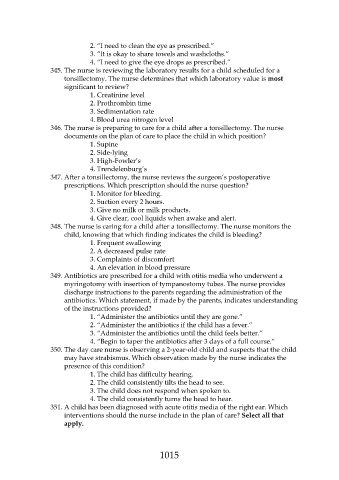Page 1015 - Saunders Comprehensive Review For NCLEX-RN
P. 1015
2. “I need to clean the eye as prescribed.”
3. “It is okay to share towels and washcloths.”
4. “I need to give the eye drops as prescribed.”
345. The nurse is reviewing the laboratory results for a child scheduled for a
tonsillectomy. The nurse determines that which laboratory value is most
significant to review?
1. Creatinine level
2. Prothrombin time
3. Sedimentation rate
4. Blood urea nitrogen level
346. The nurse is preparing to care for a child after a tonsillectomy. The nurse
documents on the plan of care to place the child in which position?
1. Supine
2. Side-lying
3. High-Fowler’s
4. Trendelenburg’s
347. After a tonsillectomy, the nurse reviews the surgeon’s postoperative
prescriptions. Which prescription should the nurse question?
1. Monitor for bleeding.
2. Suction every 2 hours.
3. Give no milk or milk products.
4. Give clear, cool liquids when awake and alert.
348. The nurse is caring for a child after a tonsillectomy. The nurse monitors the
child, knowing that which finding indicates the child is bleeding?
1. Frequent swallowing
2. A decreased pulse rate
3. Complaints of discomfort
4. An elevation in blood pressure
349. Antibiotics are prescribed for a child with otitis media who underwent a
myringotomy with insertion of tympanostomy tubes. The nurse provides
discharge instructions to the parents regarding the administration of the
antibiotics. Which statement, if made by the parents, indicates understanding
of the instructions provided?
1. “Administer the antibiotics until they are gone.”
2. “Administer the antibiotics if the child has a fever.”
3. “Administer the antibiotics until the child feels better.”
4. “Begin to taper the antibiotics after 3 days of a full course.”
350. The day care nurse is observing a 2-year-old child and suspects that the child
may have strabismus. Which observation made by the nurse indicates the
presence of this condition?
1. The child has difficulty hearing.
2. The child consistently tilts the head to see.
3. The child does not respond when spoken to.
4. The child consistently turns the head to hear.
351. A child has been diagnosed with acute otitis media of the right ear. Which
interventions should the nurse include in the plan of care? Select all that
apply.
1015

